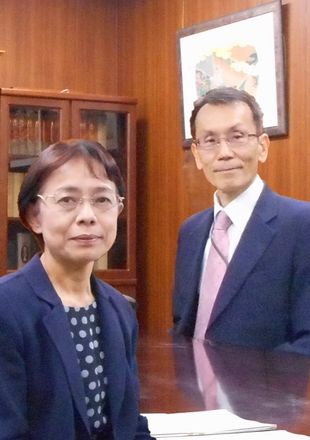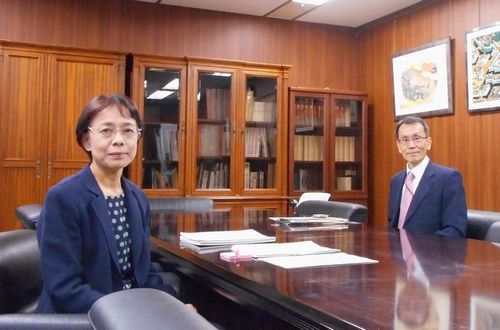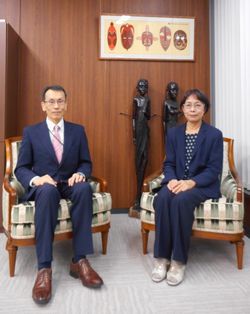A Conversation between Research Institution Leaders: the Humanities and Science and Technology Policies (Part 1)

KIBE Nobuko: President, the National Institutes for the Humanities
SAEKI Koji: Former Director General, the National Institute of Science and Technology Policy; the Ministry of Education, Culture, Sports, Science and Technology
In April 2021 the Basic Act on Science, Technology, and Innovation (revised from the Basic Act on Science and Technology) came into force, adding the promotion of the humanities and the social sciences to the scope of the law. From here on, a key task for the humanities and the social sciences is to accumulate and integrate “knowledge” with that of the natural sciences, promoting and utilizing “the convergence of knowledge” in ways conducive to comprehensively understanding and solving the challenges of humanity and society.
To explore how to drive interdisciplinary integration and research for the “convergence of knowledge,” Dr. KIBE Nobuko, president of the National Institutes for the Humanities (NIHU), invited Mr. SAEKI Koji in November 2022 to engage in a dialogue. Mr. SAEKI, who was then Director General of the National Institute of Science and Technology Policy (NISTEP), the Ministry of Education, Culture, Sports, Science and Technology (MEXT), has ties with various organizations and scholars in the natural sciences. The first part of the conversation highlights examples of cross-disciplinary integration efforts on which the two have worked.
Japanese Dialect Corpus
KIBE: My research at the National Institute for Japanese Language and Linguistics (NINJAL) focused on local dialects rather than “kyōtsūgo” standard Japanese, the Tokyo-based linguistic usage commonly among Japanese. I aspired to bring more attention to the value of dialects, because otherwise, the public would neither appreciate the diverse nature of Japanese nor the significance of the variety in our language.
Of the studies I worked on after transferring to NINJAL from Kagoshima University, two were cross-disciplinary endeavors. One was an effort to develop the Corpus of Japanese Dialects (COJADS). At the time, NINJAL had a corpus—a program compiling massive amounts of language data into a user-friendly and searchable format—for the standard Japanese, but there wasn’t one for dialects. Eager to fill this gap, I started to lead a project in 2014 to design COJADS. I don’t know how this ties in with the revision of the Basic Act, but I realized that building a digitized and properly functioning dialect search program was obviously not a task that we humanities scholars could handle alone; it was imperative that we work with information science specialists. Our team accordingly began to apply and coordinate with informatics for the project, driven by my awareness that from here on, collaboration was essential for research endeavors in the humanities.
I cannot pinpoint how COJADS specifically contributes to society, as humanities studies do not produce immediate results visible to the public eye. But I do recall sharing data with some artificial intelligence (AI) laboratories during my time at NINJAL. Scholars had approached me hoping to analyze not only standard Japanese but also diverse datasets to enhance the accuracy of their AI programs.
Genome Sequencing and Linguistic Studies
KIBE: The other study that concerned interdisciplinary teamwork was led by Dr. SAITOU Naruya, a geneticist at the National Institute of Genetics. He invited me into a project aimed at identifying the characteristics of the human groups that historically inhabited the Japanese archipelago (“Yaponesia”) and tracing the ethnic origins of Japanese. To this end, Dr. SAITOU endeavored to merge archaeological and linguistic studies with the genome sequencing results of ancient and modern humans, plants, and animals, and accordingly examine any correlation between genome analyses and language variations in Yaponesia. This project, titled the “Origin and Formation of Yaponesians Based on Genome Sequences,” was funded by the MEXT’s Grants-in-Aid for Scientific Research on Innovative Areas and continued until March 2023. Genome sequencing has been enjoying great advances of late in the field of genetics. But in reality, the process of deriving conclusions requires more than just comparing datasets, so figuring out the origins of the modern Japanese people remains a difficult task. Still, I think the launch of this and other interdisciplinary projects have, despite their slow progress, allowed for the humanities to broaden horizons and expand collaborative opportunities.
SAEKI: So the thinking behind the Yaponesia project is that when humans migrate, they bring their language with them.
KIBE:Exactly.

Scene from the conversation
The Ethics of Human Cloning
SAEKI: I had opportunities for exchange with scholars of the humanities and the social sciences when I was in charge of bioethics at a governmental agency. A 1997 report revealing the birth of Dolly, the cloned sheep, sparked an international debate about the potential and necessity of banning the application of similar technologies to human cloning. An intuitive and straightforward reaction to this issue would be to outlaw such techniques. But discerning the exact problem and the appropriate approach to regulating human clones was really challenging. Extreme examples are easy to dismiss: for instance, it is clearly unacceptable to let people duplicate themselves for organ transplants to provide against future illness. But what was wrong with people wanting to use cloning to bring back their child who died young? This was where things became complicated. And there were even groups emerging with plans to use cloning technologies to treat infertile couples.
But our basic stance was that labeling someone as a “copy” or a “clone” from birth could impair the dignity of that unique individual and lead to “breeding” and “instrumentalizing” humans. Further, since cloning does not require large facilities or equipment, in order to render regulations effective and capable of deterring misuse of the technology, these issues called for legal restrictions paired with severe penalties. But it was not so easy to impose that stiff level of regulatory control just for the protection of human dignity, and again the natural sciences could not single-handedly deal with in-depth discussions on such themes as “the nature of human birth” or “the definition of a private person.” So, scholars of the social sciences including law, religious studies, and various other specialists were brought in and we engaged in a very difficult debate.
Another factor that further complicated discussions at the time was the advent of the technology to isolate the human embryonic stem (ES) cell, the pluripotent cell that can be isolated from an embryo and develop into any organ. Cloning entails transferring the nucleus of a person’s somatic cell into an oocyte and reprogramming the nucleus to make the egg behave like a fertilized one. The result is a human with the same genetic make-up as the original cell donor. The two technologies have different purposes, but the debate grew convoluted because both meddle with nascent human life. Why should one approach be banned and the other permitted? We had a very hard time tackling this question.
It was during this period that I realized that Japan lacked groundwork for regular discussions on these topics. Countries favoring a certain religion, for instance, have a baseline mindset for the beginning of life, which shapes their stance on embryo manipulations. By contrast, in Japan, it is not easy to decide what criteria to adopt. Societal debate on ethical themes has been scant as well. I felt that without a foundation for dialog on such topics, science in Japan could in time struggle to advance.
One example is genome editing technologies. Progress is underway in this field, but a possible point of debate is the extent to which the technologies can be applied. For instance, can they be used to enhance human capabilities?
KIBE: That is indeed a tough issue to resolve.
SAEKI: Still, I have always felt the need to discuss potential reactions from society when pursuing scientific and technological progress, despite this being a complex task. I think the revision of the Basic Act has finally united the natural sciences with the humanities and the social sciences in a legal sense.
Examples of Well-Being
SAEKI: I hope the integration of the humanities and the natural sciences will not be a means to an end, but rather, a collaborative union that drives new horizon. The Government of Japan’s Sixth Science, Technology, and Innovation Basic Plan repeatedly uses the phrase “well-being,” but defining this term and examining its value is not a task to be handled by the natural sciences. I guess it is no easy job for the humanities either.
KIBE: I agree.
SAEKI: Different scholars would have different opinions.
KIBE: In 2021, the National Museum of Ethnology (Minpaku) in Osaka hosted “Universal Museum”—Exploring the New Field of Tactile Sensation, a special exhibition that offered people including deaf and sighted people a satisfactory visiting experience by allowing them to freely touch the items on display. This is one possible approach to achieving well-being.
SAEKI: Speaking of Minpaku, an excellent example of integration between the humanities and the natural sciences is the outreach activities that Dr. OISHI Yuka—formerly a Liberal Arts Communicator and now a lecturer at Kobe University—undertook as a participant inthe Arctic Challenge for Sustainability (ArCS) project. The project, which I also was involved in, aimed to decode Arctic climate change and uncover its impact on the environment and human society. This was to be achieved by harnessing various survey methods to study the realities of the Arctic region, where the effects of global warming manifest in extreme ways. After joining the ArCS and researching environmental changes in the Arctic and their social implications, Dr. OISHI conveyed the findings of the project to the public, including junior high and high schoolers, by developing a board game called “The Arctic.” This game, created in partnership with the National Museum of Emerging Science and Innovation, is a tool to help players learn about the Arctic environment. Cross-disciplinary cooperation paved the way to concretely capturing the drastic changes in the Arctic and the complex interplay between nature and humans.
SAEKI: This would not have been possible through the sole effort of humanities scholars. Synergies between humanities and social sciences researchers and natural science academics can potentially yield new discoveries or solve mysteries. But figuring out how to best maneuver collaboration efforts remains a challenge. The first step is to create more opportunities for scholars of both ends to connect with one another.
Moderator: OHBA Go, Research Fellow, the Center for Innovative Research, the National Institutes for the Humanities
KIBE Nobuko
President, NIHU
Ph.D., Kyushu University, the Faculty of Letters. After serving as Professor at Kagoshima University and at the National Institute for Japanese Language and Linguistics (NINJAL), she assumed her present position in 2022. Her research interests are linguistics, Japanese dialectology, phonology, and phonetics.
SAEKI Koji
Former Director General (until the end of March 2023), the National Institute of Science and Technology Policy (NISTEP). After joining the former Science and Technology Agency (today’s MEXT), Saeki served as Deputy Director General of the National Space Policy Secretariat, the Cabinet Office; Director General of the Research and Development Bureau, MEXT; and Vice President of the Japan Science and Technology Agency.

